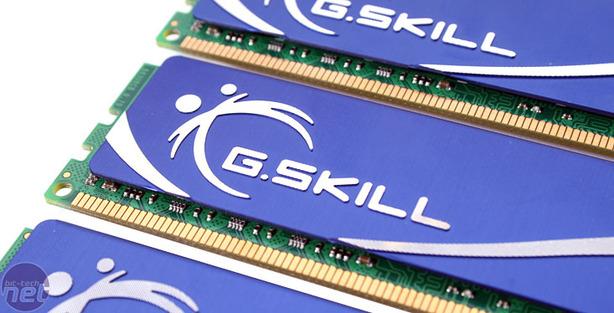Performance Conclusions
The fact that G.Skill uses Samsung HCF0 is considerable in the choice of memory. We know from past experience that these ICs will happily scale in excess of 1,900MHz, because we've reviewed several 4GB kits featuring this same IC that have achieved these speeds.The problem is, the Core i7 CPU is the limiting factor. Getting the required voltage for extreme memory speeds out of the Core i7 requires a high Uncore voltage and a fast Uncore clock. We set the CPU Uncore to 1.45V, cranked the memory voltage up to 1.90V and set the memory at 1,865MHz.
Normally Samsung HCF0 DRAMs would be happy under these conditions on an old front side bus system, but it also means the Core i7 CPU stresses the QPI a bit at 155MHz, but the biggest killer is its Uncore which now runs at 3.7GHz. Generally this is pretty massive overclock - in comparison AMD runs its own Uncore at 1.8 to 2.0GHz and it barely does more than 2.2 to 2.4GHz, even on its most recent 45nm processors.
Generally, extreme overclocking depends on the CPU, not the memory, and while we believe G.Skills Samsung HFC0 has more overhead than Corsair's Elpida modules, but at the end of the day we doubt it will believe most people's limiting factor will be their Core i7 processor. For low latency, the G.Skill certainly wins - it can do C7 without a hitch at 1,600MHz, although it requires some extra voltage to get there (which in turn requires more CPU voltage to keep within the 0.5V rule).
We have achieved 1,800MHz from this exact same memory, motherboard and BIOS combination before with the Corsair Memory, however this time we could run the G.Skill at 1,780MHz completely stable, then swap it out for the Corsair 1,600MHz DHX+ and the system would simply refuse to boot with the exact same settings.

Value
At the end of the day, we expect people to usually buy whatever looks better if you are driven by aesthetics, which means the Corsair DHX+, or what better fits your budget (what most of us will prefer) because underneath, both memories do their rated settings with ease. The G.Skill Red NQ 1,600MHz C9 which is available in the UK is just £164.70, but we're unsure whether the ICs used are also Samsung HCF0s (G.Skill refused to comment), and even though the stock performance should be very close to these from the results we've shown at C9, we have no idea about the overclocking/low latency potential.With the Corsair DHX+ at £195, the NQ C9s at £164.70 could be a good saving, however the equivalent Pi black 1,600MHz C8s are £220 - a huge price hike for a bit of extra aluminium and a slight drop in latencies.
For our friends States side get a better deal, with the G.Skill HK C8s we reviewed here available for $210 while the Corsair DHX+ 1,600MHz C8 memory is a little more at $224. US$14 isn't really much difference, though.
Final Thoughts
If we are going by US prices, at the end of the day we think the G.Skill F3-12800CL8T-6GBHK with its Samsung HCF0 ICs have slightly more overhead than the Elpida-based Corsair DHX+ modules we looked at earlier this week - if your Core i7 CPU can stretch, the memory should accommodate. It may not have anything like the funky and more importantly, moddable (but also patented), DHX+ heatsinks on the Corsair but a case with good airflow should keep the G.Skill cool enough. Moreover, they have a lifetime warranty to cover mishaps and being low profile they're less likely to chance interference with a large CPU heatsink.At the end of the day, there's not much between any of these memories, but we think the G.Skill is a good buy for our US friends at least because it still hasn't hit our shores yet.
- Performance
- x
- x
- x
- x
- x
- x
- x
- x
- x
- -
- 9/10
- Features
- x
- x
- x
- x
- x
- x
- x
- -
- -
- -
- 7/10
- Value
- x
- x
- x
- x
- x
- x
- x
- x
- -
- -
- 8/10
- Overall
- x
- x
- x
- x
- x
- x
- x
- x
- -
- -
- 8/10

MSI MPG Velox 100R Chassis Review
October 14 2021 | 15:04









Want to comment? Please log in.